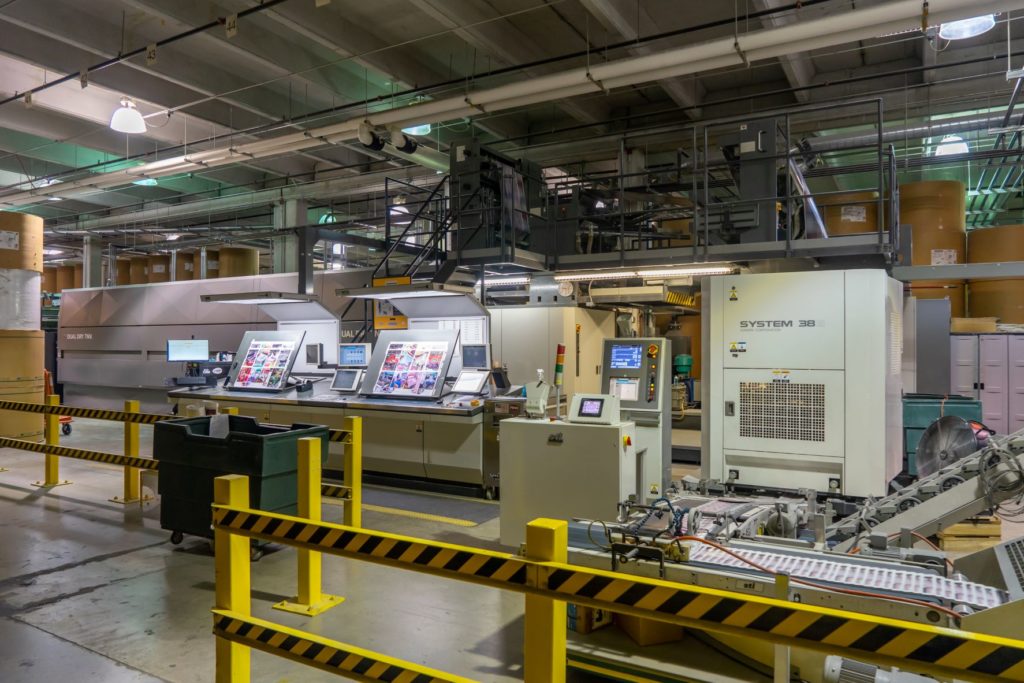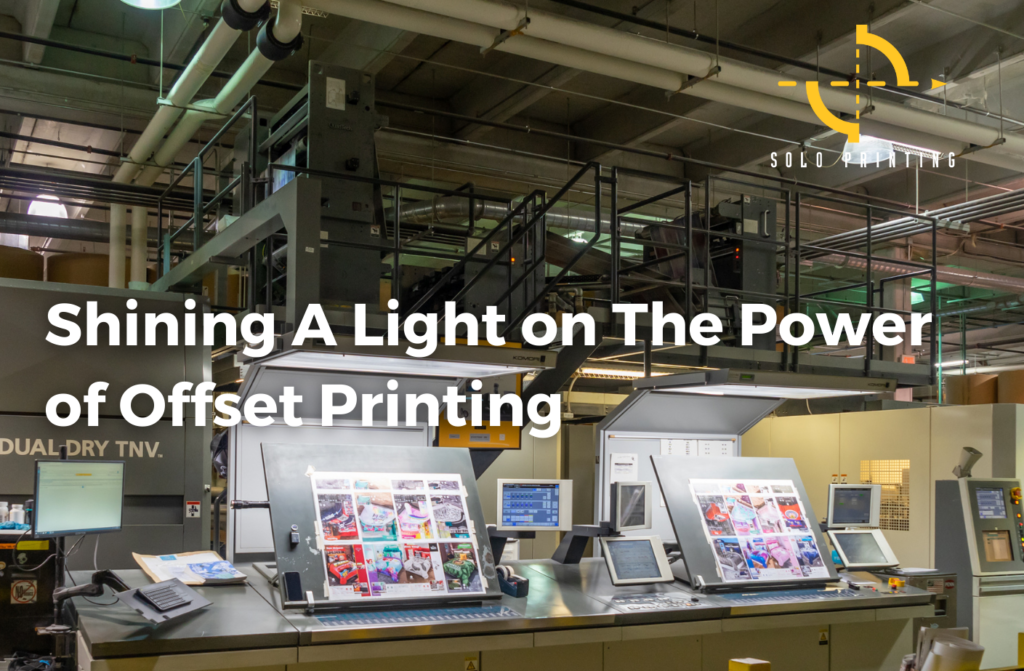Solo Printing LLC – April 1, 2022
The History on Offset Printing
In 1875, Robert Barclay patented the first rotary offset lithography printing press.
Barclay used the founding principles of mid-nineteenth-century transfer printing technology to build an offset press that used a cylinder wrapped in chemically treated cardboard that could then transfer a printed image from a stone to a metal’s surface.

Technology has come a long way since then. However, even now, we still use the power of offset printing to create high volumes of magazines, books, newspapers, and a wide range of other materials for our everyday life.
Say your business needs 25,000 catalogs for an upcoming conference. You wouldn’t send your work to a small digital printing press. The price would be astronomical, and the turnaround time would be way longer than anything you anticipated.
This is where the power of offset printing comes in.
Offset printing’s innovative press equipment produces top-quality color transferring. And, its production is one of the most top efficient printing services. Sheet-fed presses print up to 15,000 impressions per hour and web offset presses print up to 50,000!
With offset printing, the higher the quantity of print pieces needed, the cheaper the cost of each piece. This does not affect the print or color quality during production.
In fact, offset provides the highest possible print and color quality available. It also allows for a wider selection of paper choices and custom finishes. Learn more about that here.
Businesses looking to have high-volume material for their brands produced should always consider the benefits of working printing providers who have offset printing capabilities.
It’s the best way to get the best products at the best price.

What is Offset Printing?
First, it’s important to mention that there are two types of offset printing:
Web offset printing and sheet-fed printing.
Web offset printing uses one large roll of paper that is continuously printed on as it runs through the offset press. This is ideal for magazines, books, and catalogs.
Whereas sheet-fed offset printing uses sheets of paper – great for postcards, brochures, and flyers.
Offset printing is ideal for large runs demanding quick turnaround and consistent quality.
How does the process work?
Metal printing plates transfer the ink design onto a rubber blanket. The rubber blanket is then rolled onto the paper. The term “offset” is used because the ink is not printed directly onto the paper.
Web Offset Printing
In web offset printing, text and images are put on plates. Then, the images and text are transferred from the plates to a rubber blanket and then to paper. Web offset printing doesn’t produce any harmful chemicals, and it’s ideal for large printing runs because of its speed, low cost, flexibility, and consistent quality!
Web offset printing requires that you print the image you wish to reproduce onto a plate, which is then pressed onto a rubber blanker that is rolled onto the material, and ultimately creates the image on the paper. This is where the term offset comes from.
There are two types of web offset printing:
- Heatset – Once the paper is printed, the ink is dried by running the printed paper through an oven. This process is used in magazines, catalogs, and other high upscale printing products.
- Coldset – During this process, the ink dries gradually by evaporation and absorption. Coldset printing is commonly used in newspapers and is one of the most cost-effective forms of printing.
This process is most suitable for high-volume publications such as mass-market books, magazines, newspapers, catalogs, and brochures. Most high volume printing for catalogs, magazines, and books are done on web offset printing presses. This process allows us to create thousands of print pieces that reach our client’s target audiences so that they can boost their visibility and improve ROI.
Web presses are ideal for large runs of marketing collateral that help build brand awareness and visibility. Here are some examples of products:
- Booklets
- Brochures
- Catalogs
- Publications
- Direct Mail
- Free Standing Inserts
- Bill Inserts/Buckslips

The Machines
The power of offset printing is in the press and the pressmen. Luckily, Solo is equipped with the best of both!
Our two Komori 38s presses deliver exceptional quality and versatility. They maintain a full array of in-line folding and sheeting options, auto plate, close loop color, in-line aqueous and gluing, which allows us to print and assemble many products in one quick operation—saving time and money.
These presses can print tens of thousands of feet of paper per hour, and operators don’t have to keep reloading them with precut sheets.
With a web offset press, producing plenty of copies of a catalog or magazine is quick and easy. Technicians can also change plates quickly, which makes daily production much more efficient.
Key advantages of web offset printing services:
Large Jobs: web offset printing is ideal for high quantity runs where consistent quality is a requirement.
Speed: Web presses use rolls of paper instead of sheets which allows for greater speed and efficiency during the print process. Therefore, the cost of printing books, magazines, and catalogs in bulk is much more cost effective.
Paper: The cost of paper in this printing process is typically around 65-70% of the overall cost. Purchasing paper in rolls is much more cost effective than purchasing in sheets. Additionally, Solo has the buying power to purchase paper in bulk thus driving costs down.
Flexibility: Web offset printers can also accomplish additional tasks like cutting, folding, and perforating paper. Heatset web presses have drying lamps, much like a large oven, to set ink quickly for a high-quality image.
Consistent Quality: When your printing service utilizes the latest technology and Advanced Interface systems in-house, you can expect high-quality results every time with a quick turnaround.
Pantone Color Matching: If your project requires the use of the Pantone Machine System, offset printing can provide you with the most accurate match. Another bonus of web offset printing is that if you only need to print in black and white, the cost will be significantly lower and save you money.
See Our Web Offset Printing Press in Action Here: WEB-OFFSET-PRINTING-MIAMI-HD
Sheet-fed Printing
Sheet-fed printing is a premium quality of lithography that utilizes manually fed sheets of paper. It can also use a continuous feed roll that can be cut as needed. The name says it all, the paper is being fed into the printer through sheets.
Sheet-fed printing is different than web printing in which it uses paper. With web offset, a press operator continuously feeds rolls of paper into the web printer which is cut when the printing is finished. Because web offset uses paper rolls vs sheet-fed using sheets, means that web offset can create a higher number of impressions per hour.
This is one reason why sheet-fed printing is ideal for small to medium print projects.
Common sheet-fed print projects include:
- Letterhead
- Stationery
- Business cards
- Flyers
- Brochures
- Custom business forms, and more
What is the power of sheet-fed printing?
Flexibility: today, sheet-fed printing offers a higher degree of flexibility than it ever did before.
Speed: printing can execute up to 15,000 impressions per hour
Specialty Finishes: Our sheet-fed presses have the ability to create just about any finish you can imagine.
Some of these finishes are:
- Varnish – Gloss, Dull and Matte
- Aqueous – and Overall Gloss, Matte, Dull and Soft-Touch
- UV – Spot and Overall Gloss, Matte, Dull, Textured and Glitter
Automated process: the automation aspect of sheet-fed printing allows the efficiency of operations to go up, while the cost goes down.
The Machines
Solo Printing’s new 10 color and 6 color Komori GL presses offer the latest in LED UV printing technology to deliver unsurpassed quality and turn times. Our presses reproduce images beautifully in a variety of formats and a wide selection of paper stocks on 60lb text weight to a maximum of 24pt.
The presses are equipped with LED, UV and IR curing technology. Apart from being efficient, these new additions also boast a greener way of printing as a result of Komori’s many environmental initiatives that fall in line with our values of being a reduced waste and greener commercial printing company.
See Our Sheet-fed Printing Press in Action Here: SHEET-FED-PRINTING-MIAMI HD
About Solo
Solo Printing has consistent, high-quality printing, and advanced interface systems to shorten the production time, which makes for an efficient operation.
Solo Printing remains a major player in the web offset printing industry since 1985. Over the years, Solo has continuously reinvested in new presses to keep up with the latest technology that the print industry has to offer. Our (2) full size web offset presses produce consistent results of the highest quality rivaling that of sheet-fed.
Our committed web offset pressmen are some of the best in the industry with an average of 15-20 years of experience. Rest assured your high volume jobs are in good hands with us. Our web presses are ideal for large runs that demand quick turnaround and consistent quality.



